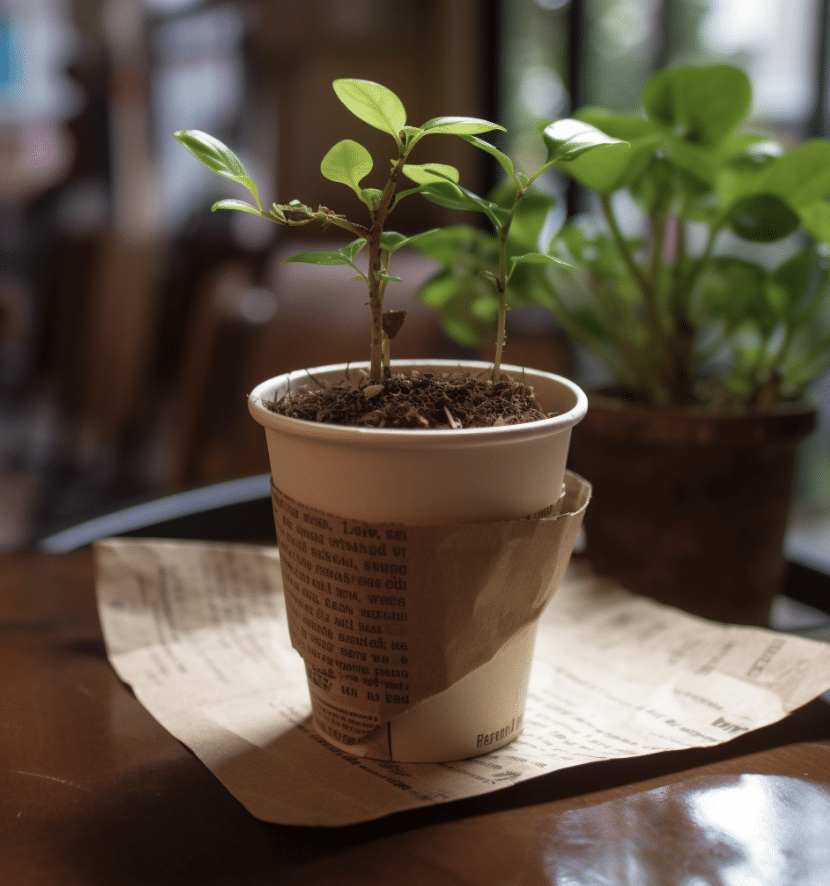Introduction – Are Coffee Cup Recyclable?
Why are people interested in coffee cup recycling? The daily ritual of coffee consumption has a massive global impact, with millions of disposable coffee cups ending up in landfills each year. The growing concern for sustainability underscores the importance of recycling coffee cups and adopting sustainable living practices. So are coffee cups recyclable? The answer might surprise you.

In this article, we will explore the materials and recyclability of various types of coffee cups, techniques for recycling them, the role of industry initiatives, and how consumers can contribute to reducing carbon emissions associated with coffee consumption. Complementary to coffee cups are options for low to zero-waste coffee-making solutions, which we do not cover in this article.
Coffee Cup Recycling: Types Of Materials, Recyclability, and Carbon Footprint
Plastic coffee cups can’t be recycled
Unusually you might think plastic coffee cups are a no-brainer but being typically made from polystyrene or polypropylene, they pose significant environmental challenges.
Although these materials are recyclable in theory, the reality is that many recycling facilities do not accept them due to food contamination and low demand for the recycled materials.
The production and disposal of plastic cups generate large amounts of greenhouse gases and nanoparticulate waste.
Paper coffee cups also can’t be recycled!
Paper coffee cups are a popular alternative to plastic, often seen as more eco-friendly. However, these cups are not as green as they seem.
Most paper cups are lined with a thin plastic layer, which makes them more difficult to recycle than standard paper products.
The recycling process requires specialized facilities and involves considerable energy consumption, resulting in substantial carbon emissions.
Only specialized coffee cups are biodegradable or recyclable
While we seem to paint a dire picture that there’s no eco-friendly way to have coffee on the go, there are in fact specialty disposable cups which are ok to go into the landfill, your compost bin, or enter the recycling process. These are specialty sustainable coffee cups which we cover on another part of our site.
Starbucks cups can’t be recycled
Starbucks, the global coffee giant, uses a type of paper cup with a plastic lining. The company has made efforts to improve the recyclability of its cups, but recycling rates remain low.
Starbucks has set targets for increasing the use of reusable cups among customers and reducing carbon emissions associated with cup manufacturing and disposal.
Reusable coffee cups and mugs WORK

Switching to reusable coffee cups and mugs made from materials such as stainless steel, ceramic, or glass offers the best solution for reducing the environmental impact of single-use coffee cups.
Reusable cups not only eliminate the need for disposables, but they significantly lower the carbon footprint associated with coffee consumption.
We review on ShrinkThatFootprint the Ecoffee cup which is a bamboo-derived reusable cup that’s shaped like a real coffee cup!
Recycling Coffee Cups: Techniques and Best Practices for Sustainable Living
Tips To prepare for coffee cup recycling
If you confirm you can recycle your coffee cup, which most of time doesn’t work (see above), then there are steps to take that will make the process easier for your recycling center.
Before recycling coffee cups, clean and separate components, such as plastic lids and sleeves. This step ensures the recyclability of the cup material and reduces contamination in the recycling process.
Find eco-friendly coffee cup recycling facilities
Efforts towards sustainable living involve seeking out local recycling centers with reduced carbon footprints that accept coffee cups. Additionally, some retailers and coffee shops offer in-store recycling programs, providing a convenient and eco-friendly option for disposing of your cups. Caveat: most recycling centers will not take the mixed materials coffee cups especially the ones with the plastic lining.
DIY repurposing of coffee cups
This is probably the best idea. Creative reuse and upcycling of coffee cups can minimize environmental impact. Turn them into planters, pencil holders, or even bird feeders. Moreover, paper coffee cups can be composted, providing an excellent sustainable alternative to recycling where facilities are unavailable. Here we provide 5 helpful ideas:

- Plant Pots: You can use your old coffee cups as pots for small plants or seedlings. Just make sure to poke a few holes in the bottom for drainage. Decorate the outside of the cups to add an artistic touch to your mini garden.
- Desk Organizers: Cut the cups to different heights and glue them together side by side, forming a handy desk organizer for pens, pencils, scissors, paperclips and other small office items. You can also wrap them in colorful paper or fabric to match your decor.
- Candle Holders: Used coffee cups can be upcycled into beautiful candle holders. Clean the cups well, then use non-flammable paints or decoupage techniques to decorate the outside. Add a tea light or a small votive candle inside. Remember to monitor any lit candles to prevent accidents.
- Bird Feeders: Poke a hole on each side of the cup close to the top, thread a piece of string through the holes, and fill the cup with birdseed. Hang this from a tree branch in your garden. Birds will soon flock to your homemade feeder.
- Craft Projects: Paper coffee cups can be an excellent material for kids’ craft projects. They can be used to make fairy houses, animals, or characters. Another idea is to create holiday-themed decorations, such as Christmas ornaments or Easter egg baskets.
Increasing the Recyclability of Coffee Cups: A Call for Change towards a Low-Carbon Future
Industry initiatives
To address the environmental impact of coffee cups, businesses are investing in innovative solutions. This includes Starbucks’ ongoing commitment to increase the recyclability of its cups, as well as the development of more sustainable packaging alternatives. Biodegradable and compostable cup materials are gaining popularity, offering a promising solution for a greener future.
Consumer advocacy and education
Promoting recycling awareness and eco-friendly behaviors are essential for encouraging sustainable living. Consumers can advocate for change by supporting businesses that prioritize reducing the environmental effects of their products and services. Choosing to use reusable coffee cups instead of disposable ones is a practical way to not only save money but also reduce carbon emissions.

Additional Tips for a Carbon-Reduced, Eco-Friendly Lifestyle
Choosing fair-trade, organic coffee beans
Sourcing ethically produced, eco-friendly coffee beans can help reduce the overall carbon footprint of your coffee consumption. Look for fair-trade and organic certifications as indicators of sustainable practices.
Efficient brewing methods with low energy consumption
Adopt brewing methods that minimize energy usage, such as using a French press or pour-over. These options require less water heating and can significantly reduce your coffee-related energy consumption.
Making sustainable choices at coffee shops
Support coffee shops that use renewable energy, locally-sourced ingredients, and ethically-produced coffee. Opt for ceramic mugs rather than disposable cups when enjoying your coffee on-site.
Advocating for change in local communities
Finally, engage with local community initiatives that promote sustainable living and recycling. Encourage friends, family, and local businesses to adopt eco-friendly practices and reduce carbon emissions.
Conclusion – Coffee Cup Recycling
Recycling coffee cups and adopting sustainable living practices are essential steps towards reducing the environmental impact of our coffee consumption habits. By collaborating with industry leaders, recycling facilities, and engaging in eco-friendly behaviors, we can pave the way for a greener, low-carbon future. Ultimately, the responsibility lies with us as consumers to push for change and prioritize a sustainable tomorrow.
